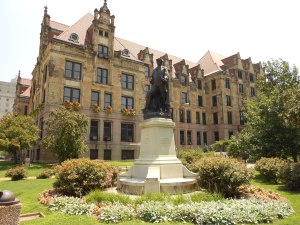Wilma Hornsey was going to be late. A recent graduate of Miss Hickey’s Secretarial School, she had only been working in the cashier’s office of Union Electric in downtown St. Louis, Missouri for a few months. She peered down Grand Avenue searching for her bus. She saw nothing but black. Even though the sun had been up for some time, the city was shrouded in a thick, black cloud.
Today, November 28, 1939, virtually everyone would be late. Day turned to night. Thick black acrid clouds covered the sky. The thick haze blotted out the winter sun and blackened the city. Street lamps were ignited, storefronts blazed, and transportation slowed or ground to a halt.
Passengers on a trolley car grew increasingly upset as the vehicle slowed on the downtown streets. One edged up and told the driver “Let me off at Thirteenth and Washington – if you can find it.” Passengers on one bus aided the driver in looking for regular patrons who seemed “lost in the fog at their accustomed street corners.” Passengers would call out the window the names of the missing, and guide them to the bus.
Motorists driving in from the suburbs said had left in a bright sunny glare. The sun disappeared when they neared the city. One commuter on Grand Avenue reported visibility was down to 10 feet and he was going 15 miles an hour. Another driver followed a white center line down a main thoroughfare, State Street, but lost his bearing when he turned onto a side street. He wound up on the sidewalk, facing the wrong way.
Parking lot attendants downtown tried to guide vehicles to the curb cuts of their respective lots, by using flashlights. One put flares in discarded oil cans and placed them at the entrance of driveways to help guide in drivers. At the corner of Grand Boulevard and Olive Street a boy hawking newspapers pretended to have a gas mask by placing a paper sack over his head with holes cut out for his eyes.
It was impossible not to inhale the smoke, even inside buildings. At City Hospital on this day nurses and interns were wearing gauze masks on their face, although few of the patients had donned them. The vapor was thick enough, said Joseph Knapp, that “you’d think you were in a coal mine. It was terrible.” Knapp, who was only 30, was in the hospital being treated for a lung ailment. “Look at the soot on my bed,” he said. “I noticed it first about 9 o’clock last night when the smoke first made me cough. It was difficult to breath.”
Edward Schanz, who was in for a heart ailment, agreed. “It made me choke and cough,” said the 65 year old. I had difficulty breathing.”
St. Louis Mayor Bernard Dickmann called his city cabinet together in an emergency meeting. They agreed that the smoke was terrible; something had to be done, but what. An aide, Raymond Tucker, reported that phone calls had been coming into City Hall all day. His office would log 240. People were angry, even abusive. St. Louis had experienced air pollution for decades, but never this bad. Dickman told his staff he was willing to take desperate measures, but he was vague when he talked to reporter late in the day. He was determined, he told them, “to rid St. Louis of the smoke menace.” The solution, he added was that “the city should keep its feet on the ground and not undertake any program without careful study.”
By mid-afternoon a slight breeze came up and began to push some of the smoke out of the city, easing traffic going home.
The smoke was the big story in the evening papers, even nearly as big as the news from Europe where the Nazis were again on the attack. The front page of the Post-Dispatch picture was striking, showing the General Grant statue at Twelfth and Market standing eerily in the dark at 9 in the morning. City Hall, which was directly behind the statue, could not be glimpsed. “St. Louis Chokes in Smoke, Ninth Big Blackout in Month,” declared the Post-Dispatch while the St. Louis Star-Times reported “Season’s Worst Smoke Pall Settles on City; Hundreds Late to Business.”
 St. Louis City Hall and the Grant Statue
St. Louis City Hall and the Grant Statue
Others were more affected and disgusted. By the end of the day Wilma Hornsey made it home to the apartment she shared with her brother and sister without any problem. She had been late to the office that morning, but no one seemed to notice. Now, she realized her white gloves were already smudged with soot. Often the coal smoke would get under her skirt, turning her white petticoat gray. Why, she wondered, were young women expected to wear so much white on these dark days?
As darkness came, the temperature fell to below freezing, and across the city people were firing their furnaces. The wind was also dying and clouds of smoke began billowing again, thickening, lowering visibility, and making people cough.
It had to feel as if God had weighed in and told the city that it was running out of time.

If I plug this gem, will it be ready by Nov. 28?
Thanks. Your St. Louis fan, Don Corrigan
LikeLike
Yes, Black Tuesday arrives on Black Friday
LikeLike